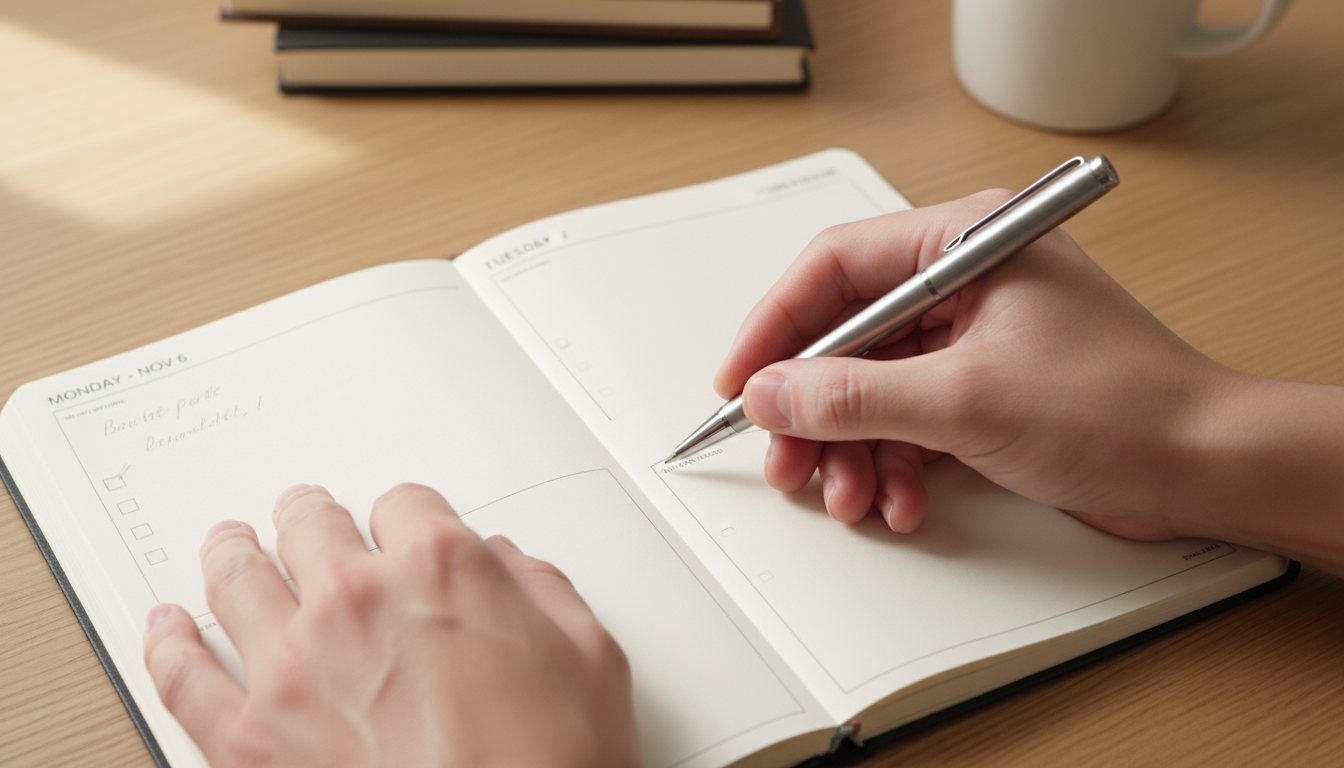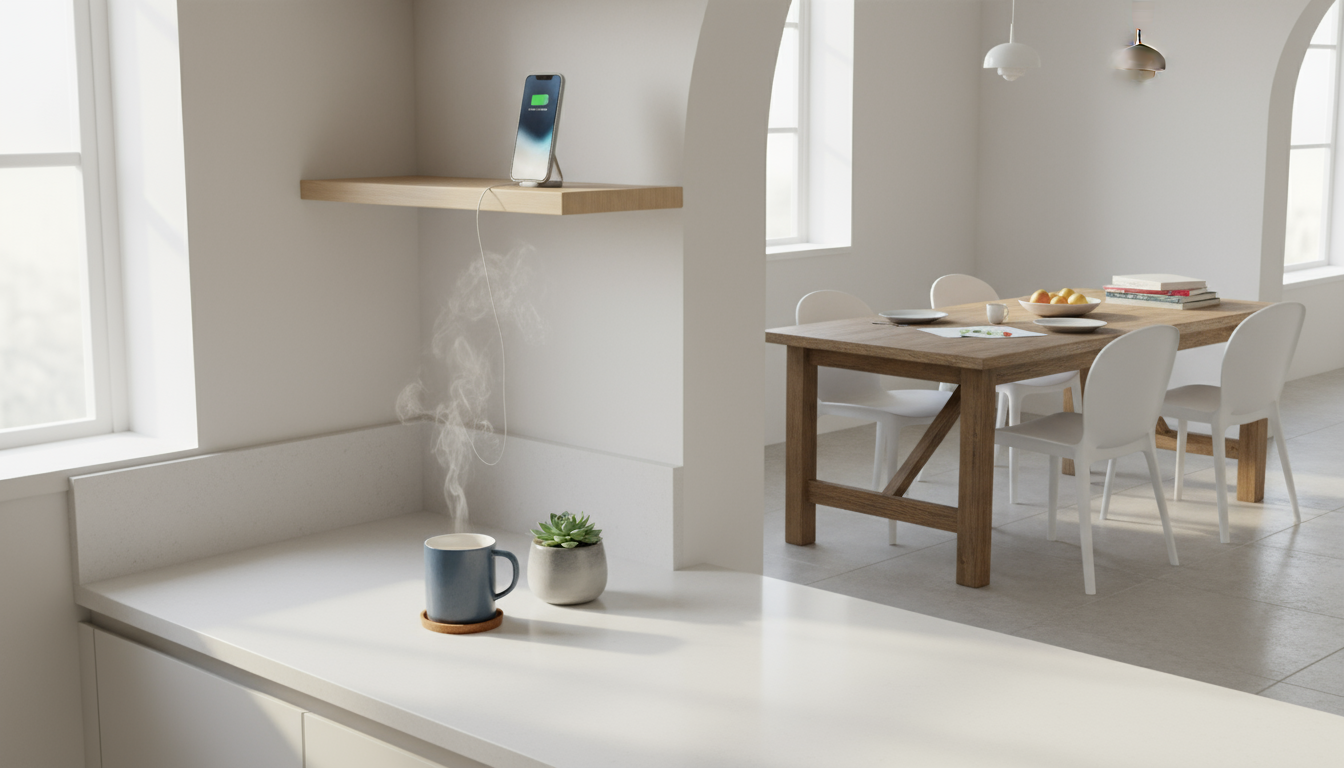
If you live in a bustling urban environment, you know the daily battle. Your morning starts with a symphony of sirens and the blue light of a dozen notifications. Your commute is a strategic game of avoiding crowded subway cars or navigating gridlocked streets. By the time you get home, your decision-making battery is completely drained. You had every intention of meditating, journaling, or prepping a healthy lunch for tomorrow, but the siren song of the couch and a streaming marathon is just too strong.
Here’s a truth we rarely acknowledge: in a world of constant overstimulation, willpower isn’t a reliable strategy. It’s a finite resource that gets depleted with every choice you make, from what to wear to how to respond to a demanding email. Relying on sheer grit to build new, positive habits is like trying to build a sandcastle during high tide. It’s exhausting, and eventually, the waves of daily life will wash it all away.
So, what’s the alternative? How do you build routines that last, even on days when your motivation is at zero? The answer isn’t about trying harder. It’s about working smarter. It’s about creating an automated system for your behavior that runs on autopilot, freeing up your precious mental energy for more important things. This system is called habit stacking, and it’s one of the most effective, gentle, and sustainable ways to transform your life, one tiny step at a time.
This guide will walk you through everything you need to know. We’ll move beyond simplistic “just do it” advice and dive into the mechanics of your brain. We will cover what habit stacking is, how to design routines that actually stick, and how to protect your progress from the inevitable chaos of life. Forget burnout and feelings of failure. It’s time to build a foundation of durable habits that support the person you want to become.
📚 Table of Contents
- Understanding the Engine: Your Brain’s Habit Loop and Your Identity
- Designing Your Stack: The Art of Intentional Routine Building
- Step 1: Start with a Minimum Viable Action
- Step 2: Conduct a Friction Audit
- Step 3: Design Your Environment for Obvious Cues
- Step 4: Incorporate Accountability
- Safeguarding Your Progress: How to Be Resilient
- Plan for Relapse: The “Never Miss Twice” Rule
- Understand the Psychology of Streaks
- How to Reset Without Shame
- Habit Stacking in Action: Two Worked Examples
- Frequently Asked Questions About Habit Stacking
- 1. How long does it actually take to build a new habit?
- 2. How do I maintain my habits when I travel or my schedule is disrupted?
- 3. I’ve been consistent for a few weeks, but now I’ve hit a plateau. What should I do?
- 4. Can I stack habits for completely different goals, like fitness and work?
- 5. What if my existing habit, the cue, is inconsistent?
- Your First Steps: A 7-Day Action Plan

Understanding the Engine: Your Brain’s Habit Loop and Your Identity
Before we can effectively build routines, we need to understand the blueprint our brains already use. We often think of our actions as conscious choices, but researchers suggest a significant portion of our day is governed by automatic behaviors—or habits. This isn’t a flaw; it’s a feature. Your brain creates these shortcuts to conserve energy. The process it uses is known as the habit loop.
Think of the habit loop as a simple, three-part neurological pattern. Understanding it is the first step in learning how to habit stack effectively. In its simplest form, the loop consists of:
- The Cue (or Trigger): This is the signal that tells your brain to go into automatic mode and which habit to use. A cue can be a time of day (waking up), a location (your kitchen), an emotional state (feeling stressed), or the action that just preceded it (finishing dinner).
- The Action (or Routine): This is the actual behavior or habit itself. It can be physical (brushing your teeth), mental (worrying about a deadline), or emotional (feeling a pang of envy when scrolling social media).
- The Reward: This is what your brain gets for completing the action. The reward signals to your brain that this particular loop is worth remembering for the future. The reward can be a physical sensation (the clean feeling in your mouth after brushing) or an emotional one (the temporary relief from boredom after opening an app).
Let’s look at a common, often unconscious, habit: checking your phone. The cue might be the sound of a notification, or even just a moment of boredom. The action is picking up your phone and opening an app. The reward is a small hit of dopamine from seeing a new post, a funny video, or a message from a friend. Because this loop is rewarding, your brain strengthens the connection between the cue and the action, making you more likely to repeat it in the future without even thinking.
Now, here’s where most people go wrong when trying to build good habits. They focus only on the action—”I need to exercise more”—without designing the cue and the reward. Without a specific cue, the action never gets triggered. Without a satisfying reward, the brain has no reason to repeat the loop. This is why a vague goal like “get healthier” so often fails.

From Doing to Being: The Power of Identity-Based Habits
Understanding the habit loop is the technical part. But to make habits truly durable, we need to connect them to something deeper: our identity. This is the concept of identity-based habits. The goal isn’t just to achieve a certain outcome (like losing 10 pounds); it’s to change your beliefs about yourself and become a new type of person.
Consider the difference between these two mindsets:
Outcome-Based Goal: “I want to run a marathon.” The focus is on the finish line. Every run is a chore you have to do to reach that singular goal. If you get injured or fall behind schedule, it’s easy to feel like a failure and quit.
Identity-Based Goal: “I want to become a runner.” The focus is on the identity. Every run, no matter how short or slow, is a vote for your new identity. You’re not just training for an event; you are embodying the traits of a runner. When you miss a day, it doesn’t negate your identity. You’re still a runner; you just took a day off.
This shift from “I want to have this” to “I want to be this” is profound. When your habits are aligned with your desired identity, you are no longer fighting against yourself. Every small action reinforces your self-image. You don’t meditate because you have to; you meditate because you are a calm and mindful person. You don’t force yourself to read; you read because you are a learner. This internal alignment provides a deep, intrinsic motivation that willpower alone can never match. Before you start building your habits, ask yourself not just “What do I want to achieve?” but “Who do I wish to become?”

Designing Your Stack: The Art of Intentional Routine Building
Now that we understand the mechanics of the habit loop and the importance of identity, we can get to the core strategy: habit stacking. So, what is habit stacking? It’s a method for building new habits by attaching them to existing ones. Instead of relying on a time or location to be your cue, you use a current, well-established habit as the trigger for the new one you want to adopt.
The basic formula for habit stacking is:
After [CURRENT HABIT], I will [NEW HABIT].
The beauty of this approach is its simplicity. You already have dozens, if not hundreds, of strong habits baked into your daily life: waking up, brushing your teeth, making coffee, putting on your shoes, eating lunch. These are solid neural pathways in your brain. By linking a new, desired behavior to one of these existing pathways, you leverage the brain’s natural momentum. You’re not creating a new habit loop from scratch; you’re simply inserting a new action into an existing one.

Step 1: Start with a Minimum Viable Action
The biggest mistake people make when building habits is starting too big. We declare, “I’m going to work out for an hour every day!” After two days of intense soreness and a disrupted schedule, we quit. Our ambition outpaces our ability to be consistent.
The solution is to define what we can call a minimum viable action (MVA). This is the smallest, easiest version of your desired habit—a version so simple that you can’t say no. The MVA is not about making massive progress on day one. It’s about showing up and casting a vote for your new identity. It’s about mastering the art of starting.
Here’s how to reframe ambitious goals into MVAs:
- “Read more” becomes “Read one page.”
- “Meditate for 20 minutes” becomes “Sit and breathe for 60 seconds.”
- “Clean the whole house” becomes “Put one item away.”
- “Write a book” becomes “Write one sentence.”
It might sound laughably simple, but that’s the point. On your busiest, most stressful day, you can still read one page. You can still breathe for one minute. The MVA makes consistency almost effortless. Once the habit of showing up is established, you can gradually increase the duration or intensity. But first, you must build the foundation of consistency. When you think about how to habit stack, always begin by pairing a current habit with a minimum viable action.

Step 2: Conduct a Friction Audit
Every action in your life has a certain amount of friction associated with it. Friction is anything that makes a behavior harder to do. The more steps, time, or effort required, the higher the friction. Our brains are wired to follow the path of least resistance. You can use this to your advantage by intentionally manipulating friction in your environment.
To build a good habit, you must decrease the friction. To break a bad habit, you must increase it. Let’s conduct a quick friction audit for a habit stack you might want to build:
Goal: Meditate for one minute after brewing your morning coffee.
Current Friction Points: You don’t know how to meditate. Your phone with the meditation app is in another room. The kitchen is noisy and your family is walking around.
How to Decrease Friction:
– Download a simple meditation app beforehand and pick out a one-minute guided meditation.
– Create a rule that your phone stays on the kitchen counter overnight.
– Designate a specific chair in the corner of the kitchen as your “meditation spot.”
By making these small adjustments, you’ve removed the obstacles that stand between you and your desired action. The path of least resistance now leads directly to your one-minute meditation. Conversely, if you wanted to stop checking your phone first thing in the morning, you could increase the friction by leaving it to charge in the living room overnight. When your alarm goes off, you’d have to physically get out of bed and walk to another room to turn it off, making it much harder to mindlessly scroll.
Step 3: Design Your Environment for Obvious Cues
Your environment is a powerful, invisible hand that shapes your behavior. The most effective way to stick with your habits is to make the cues for your good habits obvious and visible. If your goal is to drink more water, don’t hide a glass in the cupboard; leave a water bottle on your desk, next to your bed, and on the kitchen counter. You are creating visual triggers that constantly prompt the desired action.
This principle is essential for successful habit stacking. Your environment should support the chain of behaviors you’re trying to build. Let’s say you want to build a routine where you journal for five minutes after you finish your morning coffee. How can you design your environment?
After I finish my coffee, I will journal for five minutes.
Environmental Design: The night before, place your journal and a pen on the kitchen table, right next to your coffee maker. When you go to pour your cup, the cue (the journal) for your next action is unmissable. You don’t have to remember to journal. You don’t have to find your pen. The environment does the work for you.

Step 4: Incorporate Accountability
While habit stacking is an internal system, external accountability can be a powerful motivator. Knowing that someone else is aware of your goals creates a gentle social pressure to follow through. This doesn’t have to be intense or high-stakes. It can be as simple as having a “habit buddy.”
You and a friend can agree to text each other each morning after you’ve completed your new habit. For example: “Done with my one-minute meditation!” This simple act of checking in does two things. First, it creates an immediate reward—the satisfaction of sending the text and getting a positive response. Second, it raises the stakes ever so slightly. We are less likely to skip a habit when we know we have to report back to someone. The desire to maintain our reputation and be seen as consistent is a strong behavioral driver. Find someone in your life who also wants to build routines and suggest becoming accountability partners. It can make all the difference, especially in the early days.
![]()
Safeguarding Your Progress: How to Be Resilient
Building new habits is rarely a perfect, linear process. Life happens. You’ll get sick, travel for work, or have a day where everything falls apart. A rigid, all-or-nothing mindset is the fastest way to derail your progress. The key to long-term success isn’t perfection; it’s resilience. It’s about having a plan for when things go wrong so you can get back on track quickly and without shame.

Plan for Relapse: The “Never Miss Twice” Rule
Everyone misses a day. The problem isn’t the single mistake; it’s the downward spiral that can follow. We miss one workout and think, “Well, I’ve already broken the streak, I might as well skip the rest of the week and start over on Monday.” This is a cognitive trap.
A more compassionate and effective approach is the “never miss twice” rule. It’s built on the understanding that one missed day is an anomaly, but two missed days is the beginning of a new, undesirable habit. This rule gives you permission to be human. You can have an off day. But it also creates a clear, simple imperative: get back on track immediately.
If you miss your habit of reading one page after dinner, don’t beat yourself up. Acknowledge it, and make a firm commitment to read your one page tomorrow. The focus shifts from maintaining a perfect record to building a resilient practice. By refusing to let one slip-up become two, you protect your identity. You are still a reader; you just had a busy evening. This simple rule prevents a small stumble from turning into a complete abandonment of your goals.

Understand the Psychology of Streaks
Tracking your habits and building a “streak”—a chain of consecutive days you’ve completed your habit—can be incredibly motivating. Seeing a visual representation of your consistency, like a line of X’s on a calendar, taps into our brain’s reward system and our desire for completion. It can provide the extra push you need to show up on a day you feel uninspired.
However, streaks can also be a double-edged sword. If you place too much importance on an unbroken chain, a single missed day can feel catastrophic. The shame of “breaking the streak” can be so demotivating that it causes you to quit altogether. The tool that was meant to inspire you becomes a source of pressure and anxiety.
The key is to use streaks as a tool for motivation, not a measure of your self-worth. If you enjoy tracking, do it. But hold it lightly. Celebrate a long streak as evidence of your hard work, but if it breaks, immediately apply the “never miss twice” rule. Remember, the goal is not to have a perfect calendar. The goal is to build a durable habit and reinforce your identity. One empty square on the calendar doesn’t erase the hundreds of X’s that came before it.

How to Reset Without Shame
Let’s say you go on vacation for a week and your carefully crafted routines fall apart. You come home feeling sluggish and discouraged. The thought of starting all over again feels daunting. This is a critical moment. Your internal narrative will determine what happens next.
The shame-based narrative says: “I failed. I lost all my progress. I knew I couldn’t do it.” This story leads to inaction.
The compassionate, resilient narrative says: “I took a break to rest and enjoy myself. Now it’s time to reactivate my systems. What’s the minimum viable action I can take right now to get back on track?” This story leads to action.
When you need to reset, always return to your minimum viable action. Don’t try to jump back in at the level you were at before the break. If you were meditating for 10 minutes, go back to one minute. If you were running three miles, go for a 10-minute walk. The goal is to get a quick, easy win. Re-establish the pattern of showing up. The momentum will return much faster than you think. Treat these moments not as failures, but as planned pit stops on a very long journey. There is no finish line in habit building; there is only the practice.

Habit Stacking in Action: Two Worked Examples
Theory is helpful, but seeing how these principles come together in a practical routine can make it all click. Let’s design two simple but powerful habit stacks, one for winding down in the evening and one for priming your focus in the morning. Notice how each new habit is a minimum viable action linked to a strong, existing cue.

Example 1: The Evening Wind-Down Routine
Desired Identity: “I am a calm person who sleeps well and prepares for the next day.”
The Problem: You often stay up late scrolling on your phone or watching TV, which makes it hard to fall asleep. You wake up feeling groggy and unprepared for the day.
The Habit Stack:
This routine is designed to create a cascade of behaviors that signal to your brain and body that it’s time for rest. It starts with a common, hard-wired cue: finishing dinner.
“After I put my last dish in the dishwasher (the cue), I will immediately wipe down the kitchen counters (the MVA for ‘clean home’). This small act of tidying creates a sense of closure on the day.”
“After the counters are clean (new cue), I will set out my clothes for tomorrow (the MVA for ‘organized person’). This removes a point of friction and a decision from the next morning, making it easier to start the day smoothly.”
“After my clothes are set out (new cue), I will walk to my bedroom and plug my phone in to charge across the room, not next to my bed (the MVA for ‘disconnected rest’). This increases the friction for late-night scrolling and creates a tech-free sleep environment.”
“After my phone is plugged in (new cue), I will sit on my bed and read one page from a physical book (the MVA for ‘reader’). This helps my mind detach from the stimulating blue light of screens and ease into a restful state.”
In just a few minutes, this chain of tiny habits has cleaned your kitchen, prepared you for the morning, created a better sleep environment, and helped you wind down without requiring any significant willpower.

Example 2: The Morning Focus Primer
Desired Identity: “I am a focused and intentional person who owns my morning.”
The Problem: You wake up and immediately grab your phone, flooding your brain with emails, news, and social media. You start your day in a reactive, distracted state.
The Habit Stack:
This routine is designed to protect the first few minutes of your day, allowing you to be proactive instead of reactive. The primary cue is one you can’t miss: turning off your morning alarm.
“After I turn off my alarm (the cue), I will immediately sit up in bed and drink the glass of water I placed on my nightstand the night before (the MVA for ‘healthy person’). This simple act rehydrates you after a long sleep.”
“After I finish the glass of water (new cue), I will sit quietly and take three deep breaths, focusing on the feeling of the air moving in and out (the MVA for ‘mindful person’). This is a micro-meditation that calms your nervous system instead of agitating it with notifications.”
“After my three deep breaths (new cue), I will open the journal on my nightstand and write down one thing I am grateful for (the MVA for ‘positive person’). This primes your brain to look for the good in your day.”
“After I write my one sentence of gratitude (new cue), I will stand up and make my bed (the MVA for ‘disciplined person’). This is a small ‘win’ that creates a sense of accomplishment and order to start your day.”
This entire sequence can be completed in less than five minutes. Before your mind has a chance to get pulled into the digital world, you have already invested in your physical health, mental clarity, and emotional well-being, setting a powerful tone for the rest of your day.

Frequently Asked Questions About Habit Stacking
As you begin to build your own routines, questions will naturally arise. Here are answers to some of the most common queries we see, designed to give you clarity and confidence as you move forward.
1. How long does it actually take to build a new habit?
You’ve probably heard the number “21 days.” Unfortunately, this is a myth based on a misinterpretation of an old study. More recent research shows that the time it takes for a habit to become automatic can vary wildly, from as little as 18 days to as long as 254 days. The average is around 66 days. The complexity of the habit and the consistency of your practice are the biggest factors. The key takeaway is to stop focusing on a magic number. Instead, focus on the process. Put your energy into showing up each day with your minimum viable action and applying the “never miss twice” rule. The habit will become automatic when it’s ready. The goal is consistency, not speed.
2. How do I maintain my habits when I travel or my schedule is disrupted?
This is where the minimum viable action truly shines. The goal during periods of disruption is not to perform your habits perfectly, but to maintain the thread of consistency. If your habit is to do 20 push-ups after making your bed, your travel MVA might be to do just one push-up in your hotel room. If you normally journal for 10 minutes, your travel version might be to write one sentence on a napkin. It might feel silly, but you are still casting a vote for your identity. You are reminding your brain that this is who you are, even when you’re in a different environment. This makes it infinitely easier to ramp back up to your normal routine when you return home.
3. I’ve been consistent for a few weeks, but now I’ve hit a plateau. What should I do?
Plateaus are a normal part of any growth process. Often, they signal that your brain has adapted to the current level of difficulty and it’s time for a small, intentional change. This doesn’t mean you need to make a massive leap. If you’ve been consistently meditating for two minutes, try extending it to three. If you’ve been reading one page, try for two. Another strategy is to focus on improving the quality of the habit. If you’ve been walking for 15 minutes, perhaps you can focus on your posture or walking a bit more briskly during that time. The key is to introduce a small, novel challenge to keep your brain engaged without making the habit so difficult that you want to quit. Progress isn’t always linear; sometimes it involves periods of stability followed by small, deliberate steps forward.
4. Can I stack habits for completely different goals, like fitness and work?
Absolutely. That’s one of the strengths of habit stacking. Your brain doesn’t care if the habits are related; it only cares about the reliable sequence of cue and action. For example, you could easily build a stack that bridges different areas of your life. A routine could look like this: After I finish my last work email for the day (work cue), I will immediately change into my workout clothes (fitness action). In this case, the end of the workday becomes a powerful trigger to kickstart your health routine. The key is to find a “gateway” habit that serves as a solid anchor. Shutting down your computer is a definitive end to one part of your day, making it an excellent cue to launch the next sequence.
5. What if my existing habit, the cue, is inconsistent?
This is a great question and highlights the importance of choosing a solid anchor habit. You want to tie your new habit to something that happens reliably every single day without fail. “Brushing my teeth” is a great anchor. “Eating lunch at my desk” might not be, as some days you might go out for lunch. If your chosen cue is proving to be unreliable, simply swap it for one that is. Make a list of things you do every single day, no matter what. These are your best candidates for cues: getting out of bed, taking a shower, making coffee, locking your front door, getting back in your car after work, putting on your pajamas. Choose the most rock-solid habit you have as the foundation for your new stack.
Disclaimer: The information provided in this article is for educational and informational purposes only and is not intended as a substitute for advice from your physician or other qualified health care professional. Always seek the advice of a professional for any questions you may have regarding a medical or psychological condition.

Your First Steps: A 7-Day Action Plan
You now have a complete framework for understanding and implementing habit stacking. You know the importance of the habit loop, the power of identity, and the practical steps of designing and safeguarding your routines. But knowledge is only potential. Action is what creates change. Let’s bridge that gap right now.
Instead of feeling overwhelmed by all the possibilities, your goal for the next week is simply to build one habit stack. We are going to start small to win big. Here are your next three actions:
- Choose Your Identity (Today): Before you do anything else, take five minutes to answer the question: “Who do I wish to become?” Don’t focus on outcomes. Focus on character. Do you want to be a writer? A mindful person? An organized student? A healthy parent? Write it down. This identity will be your north star.
- Design Your First Stack (Today): Based on your chosen identity, pick one new behavior you want to introduce. Now, shrink it down to its minimum viable action—so easy you can’t say no. Next, identify a rock-solid, existing daily habit to be your cue. Finally, write out your habit stack formula: “After [Current Habit], I will [New Minimum Viable Action].” For example: “After I set my coffee to brew, I will do two push-ups.”
- Execute and Track (Next 7 Days): For the next seven days, your only goal is to execute that one stack. Don’t add anything else. Don’t increase the difficulty. Just show up and perform your tiny action. Mark an ‘X’ on a calendar for each day you complete it. If you miss a day, immediately invoke the “never miss twice” rule and get back on track the next day. The goal is not perfection; it’s to build the initial neural pathway for this new routine.
Building durable habits is not a dramatic, overnight transformation. It is a quiet, gentle, and steady process of laying one brick at a time. By using habit stacking, you are choosing a smarter path—one that works with your brain’s natural wiring, not against it. You are building a system that can withstand the chaos of modern life, creating a foundation of positive behaviors that will support you for years to come. Start today. Start small. The person you want to become is waiting.
For expert guidance on productivity and focus, visit OSHA Ergonomics, National Institutes of Health (NIH), National Sleep Foundation, American Institute of Stress and Mindful.org.






